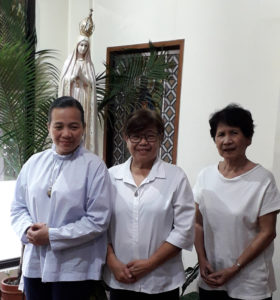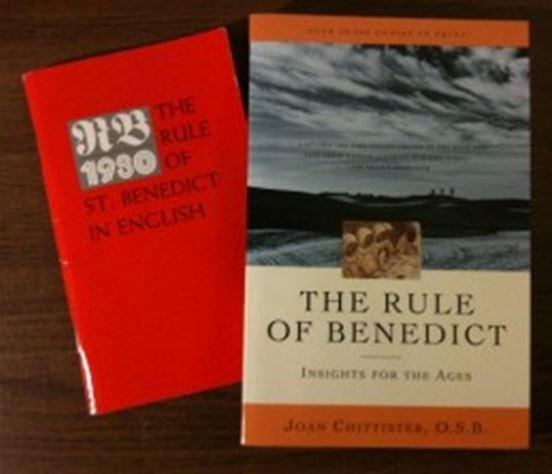Oblates
OBLATES OF ST. BENEDICT
of the Missionary Benedictine Sisters of Tutzing, Manila Priory
By Sr. Pia Lansang, OSB
BIRTH OF A PRIORY MINISTRY OF BENEDICTINE LAY FORMATION
Early Beginnings in the Context of the Oblates of St. Benedict
The establishment of the first group of Oblates of St. Benedict in our Manila Priory in 1969/70 was the brainchild of one of our former German Benedictine Prioresses, Sr. Assumpta Filser, OSB (term,1965-1970). Having the heart of a longtime and seasoned Formator as Novice Mistress of the Manila Priory before assuming the office of prioress, she envisioned a program of continuing spiritual contact with graduates of our educational institutions like St. Scholastica’s College, Manila.
Sr. Assumpta was aware of the students’ privilege of long exposure to and familiarity with Benedictine culture and spirituality through the years. Her concern was that this process would not be abruptly cut-off upon graduation from a Benedictine school. She saw the potential in sustaining the momentum and benefit by continuing to nourish the alumnae with the wealth of Benedictine spirituality way beyond their years in school.

Thus, as they transitioned into the world of professional life and developed their own career options in business or employment, the alumnae would still have some profitable access to the wealth of Benedictine life and spirituality. Successive batches of graduates, the majority of which started families of their own also offered another rich pasture for the continuing promotion of the ideals of St. Benedict and his gospel-inspired Rule (RB). For therein was also a new stepping stone to family-apostolate — reaching out to heads of families and spreading out to the larger communities of parishes and neighborhoods where they could become one visible form of Benedictine influence among the laity.
Whereas, Benedictine Oblates in themselves are a commonly existing entity in many Benedictine monasteries of both men and women around the world (to some other monasteries these are simply called “Associates”), the Manila priory then invited those who felt called to become lay spiritual affiliates to the Benedictine community as Oblates of St. Benedict. Thereby these committed themselves to participate in a program of Benedictine formation designed for the laity living in the world And as having Oblates would not mean generating a mass movement, the first group of alumnae was, at the time, a small group exclusively from Manila.
AST FORWARD: OUR OBLATES TODAY
Today’s landscape of Oblates of the Manila Priory has widely changed. Gradually, through the mentoring of generations of MBS Oblate Moderators, the group has branched out and expanded to our out-stations such as Baguio, Marikina, Legazpi, Bacolod, Tabunok, Marihatag, not counting those which are currently germinating as future Oblate groups. Spread out into the MBS various schools and health and social centers, but also from outside our institutions, these currently number about a hundred, this means adding the groups from out-stations to the 60-70 of Manila (both fully active and “irregulars” – such as those who attend twice-a-year Retreats and other activities).
Moreover, Oblates affiliated to us MBS developed into a gender inclusive group – they are laymen and laywomen from all walks of life. They also cut across different states and status of life: married, single, raising a family as couples or as single parent, thus, and in rare instances even resulting in membership of a whole family.

IDENTITY AND MISSION
Undergoing a 2-3 years of formation, the Rule of St. Benedict (RB) is the basic formative document. Of equal importance is the Bible, since the RB is steeped in the Scriptures which Benedict profoundly uses as a foundational source. Many Oblates affirm with gratitude their experience of Benedictine prayer as a great enhancement of their spiritual life. In particular, the Eucharist, the Divine Office, and Lectio Divina which are the pillars of a Christ-centered Benedictine spirituality become to them a source of strengthening their relationship to God a daily support in meeting life’s challenges. Striving to make prayer, Church prayer and individual prayer, an indispensable part of their life is an important mission and service to the world. From this flows the genuine service render to their families and others.
The of Final Oblation which is a recognized and duly approved Rite of the Church is the culminating event where the Prioress (or the local Superior), receives the Oblate’s promises, in the presence of the community of Sisters, to dedicate herself to the service of God and humankind according to the RB insofar as her state of life permits. Although unlike monks, Nuns and Sisters, Benedictine Oblates make no vows, they can quite easily relate to the Benedictine vows of Conversatio Morum (conversion of life), Stability, and Obedience, which really are translatable to lay life in terms of an ongoing striving to become better Christians (conversion) rootedness in Christ in a restless world (fidelity, loyalty); and learning to listen to the needs of others (mutual obedience, respect and service)


By their Oblation spiritual affiliates enter into communion with the Benedictine community and share in their prayer and mission. This spiritual interaction with the community ranges from joining choir prayer of the Divine Office (which currently they do 3x-a-week online due to the pandemic) to supporting in prayer the MBS community and join in activities and the apostolates of the Sisters insofar as this is possible in their state of life. Various means are tapped such as teaching catechism, responding to victims of calamities, and raising funds through garage sales and the like and ruffle draws for the benefit of the poor and their other projects.

